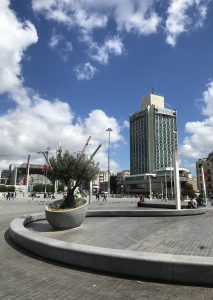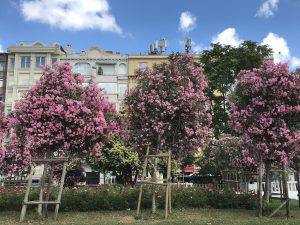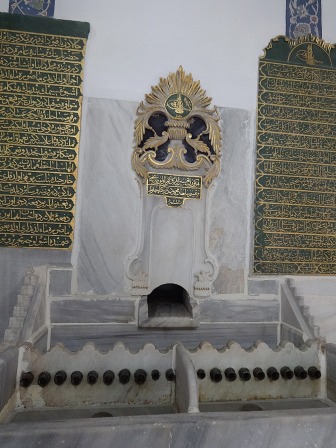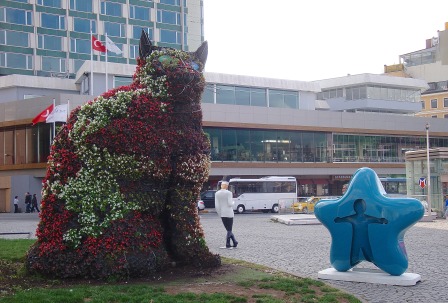Taksim Meydanı (Taksim Square) is to İstanbul what Trafalgar Square is to London or Times Square to New York. It’s here that Turks traditionally came to celebrate or protest alongside an iconic monument to Atatürk and the Turkish Republic. Alas, that is a tradition that is entirely in the past since the traumatic incidents of the Gezi Park protests in 2013. Now the Square consists of a large concrete plaza occupied only by the entrance to the Metro and with a triangular space tacked on at the side to accommodate the monument, which these days is dwarfed by the mosque built to one side.
The Square forms an important hub in a network of major thoroughfares. Gezi Park runs along the northern side with the Divan, Ceylan Intercontinental and Hyatt hotels immediately behind it and the Gezi Bosphorus Hotel beside it. Mete Caddesi runs beside Gezi Park to Maçka Park. Gümüşsuyu Caddesi runs downhill from near the Atatürk Cultural Centre to Beşiktaş. Pedestrianised İstiklal Caddesi runs straight down to Tünel and thence via the funicular to Karaköy. Sıraselviler Caddesi runs downhill from next to İstiklal Caddesi to Cihangir/Çukurcuma and on down to Tophane. Tarlabaşı Bulvarı runs from behind Taksim Cami past Tarlabaşı to Şişhane and then via the Atatürk Bridge to the far side of the Golden Horn. Cumhuriyet Caddesi runs from the western side of Gezi Park through Harbiye to Şişli.
Backstory
What came to be known as the Gezi incident was intricately tied up with plans for the redevelopment of Taksim Square as well as of the park up the steps to its north-east. In 2012 planning began on a new-look Taksim Square which was intended to encompass the rebuilding of the Taksim Artillery Barracks (Taksim Topcu Kışlası), a huge edifice originally erected in 1802 – possibly under the supervision of Kirkor Balyan – and given a Moorish appearance reminiscent of the entrance to Istanbul University in Beyazıt fifty years later. From 1918 to 1941 the barracks was reused as a sports stadium before being demolished. Taksim Square itself started out as the parade ground in front of the barracks.
Since the barracks had included a mosque its recreation would have facilitated the introduction of a mosque into an area seen as symbolic of the Turkish Republic. This was bound to prove controversial, as was the suggestion that the new “barracks” would house another shopping mall with the inevitable loss of a rare piece of green space in Beyoğlu.
The original barracks had been built over a cemetery on the site of what is now Gezi Park, an insignificant patch of greenery with a somewhat dubious after-dark reputation that shot to fame in the summer of 2013 when protests against its destruction in favour of the rebuilt barracks sparked a sit-in and a heavy-handed police reaction. Weeks of turmoil followed, not just in İstanbul but all over the country. As a result several people died, several more were blinded and many hundreds were injured.
 Around the Square
Around the Square
The eastern side of the square is occupied by the Atatürk Cultural Centre (AKM). The original building was designed by Hayati Tabanlıoğlu in 1969 and rebuilt in 1978 after a fire. The new version (which looks very like the old one but has better acoustics) was designed by Tabanlıoğlu’s son, Murat, and opened in 2021 with a complex of shops, eateries and a library beside it.
The Marmara hotel occupies most of the south side of the square, its busy gym clearly visible to people walking across it. In 1977 more than 30 people died when shots were fired on a May Day gathering in the square from the top of what was then the Sheraton Hotel (or possibly the Water Supply company building). No one was ever convicted over the deaths, some of which probably resulted from the ensuing panic. These days no May Day gatherings are ever allowed to take place here.
The western side of the square is the most historically interesting. The monument to the founding of the Turkish Republic was erected here in 1928 and has occupied a big space in Turkish hearts ever since even though, like Eros in Piccadilly, it’s rather on the small side. The sculptures were designed by the Italian artist, Pietro Canonica, and are encased in a decorative stone frame designed by Giulio Mongeri.
The monument appears particularly small because of the size of the Taksim Cami that opened beside it in 2021. It was designed by Şefik Birkiye and fits very well into the narrow space behind the cistern commissioned along one side of the Square by Sultan Mahmud I in 1731. Externally the architecture, with its multiple domes, is a playful take on the traditional Sinan model. Inside, however, it is much less interesting, at least in my opinion.
The huge cistern (maksem) was used to store water brought into the city from the Belgrade Forest ready for distribution via the little stone taksim (water distribution point, 1723) at the top of İstiklal Caddesi. The cistern is now used for temporary exhibitions while the taksim has been turned into an information centre.
If you walk down Mete Caddesi along the east side of Gezi Park you will come to the distinctive Atatürk Kitaplığı (Atatürk Library) designed by Sedat Hakkı Erdem in 1976 and offering readers a spectacular Bosphorus backdrop. Cross over the road beside the Grand Hyatt Hotel and you will come eventually to Maçka Demokrasi Park and the small cable-car that whisks passengers across to Maçka and Nişantaşı. On the way you will pass, on the right, the imposing Taşkışla (Stone Barracks), designed originally as a military hospital in 1846 by the British architect, William James Smith. Later it became the Mecidiye Kışla (Mecidiye Barracks). Today it houses part of İstanbul Technical University.

As for Gezi Park itself, now that the dust has settled what’s left is a small, quiet oasis in a busy part of the city where people can sit beneath ornamental trees, downing the odd çay and watching the world go by. From 1560 to 1939 a large Armenian cemetery lay under what is now the park alongside a more general foreign cemetery known as Les Champs de Mort. But the French town planner, Henri Prost, wanted to open a green corridor through this area and so the cemeteries had to go. In their place came the park, initially called the Inönü Esplanade. In Prost’s vision the greenery would have flowed almost all the way to Dolmabahçe. Instead over the years even the truncated version was slowly nibbled away at the edges.
As for the gravestones removed from the old cemetery, some can now be seen in the Feriköy cemeteries.
 Interior of the TaksimEating
Interior of the TaksimEating
Want to grab a quick, cheap bite? Then the Taksim end of İstiklal Caddesi is known for its many döner kebab stands as well as for its more unlikely ıslak (wet) burgers, a sort of Turkish take on a spicy McDonald’s.
Sleeping
A cluster of four- and five-star hotels stand in and around the Square. They all offer high-standards of accommodation, food and service. But such luxury comes at a price. Should you be after something less expensive then the adjoining Talimhane area would be a good place to start looking.
Ceylan Intercontinental. Tel: 0212-368 4444
Divan Istanbul Hotel One of Turkey’s best-known hotels, the 191-room Divan was completely rebuilt to bring it up to modern standards in 2011 and now boasts smart, modern rooms complete with iPod docks. The lobby bar is the epitome of cosy intimacy. Asker Ocağı Caddesi No 1, Elmadağ, Tel: 0212-315 5500
Gezi Hotel Bosphorus As you head uphill from the Atatürk Library to Taksim Square you will find this new hotel just across the road from Gezi Park. Bedrooms feature lavish Ottoman fabrics. Some manage Bosphorus views as does the rooftop Delma Grill Bar. Mete Caddesi No. 34, Tel: 0212-393 2700
Grand Hyatt İstanbul Hotel. Tel: 0212-368 1234
The Marmara. Tel: 0212-334 8300
Transport info
The funicular from Kabataş terminates right in Taksim Square. You can get to it by tram from Sultanahmet.
The nostalgic tram also starts its slow and stately trundle along İstiklal Caddesi from Taksim Square.
Nearby areas



